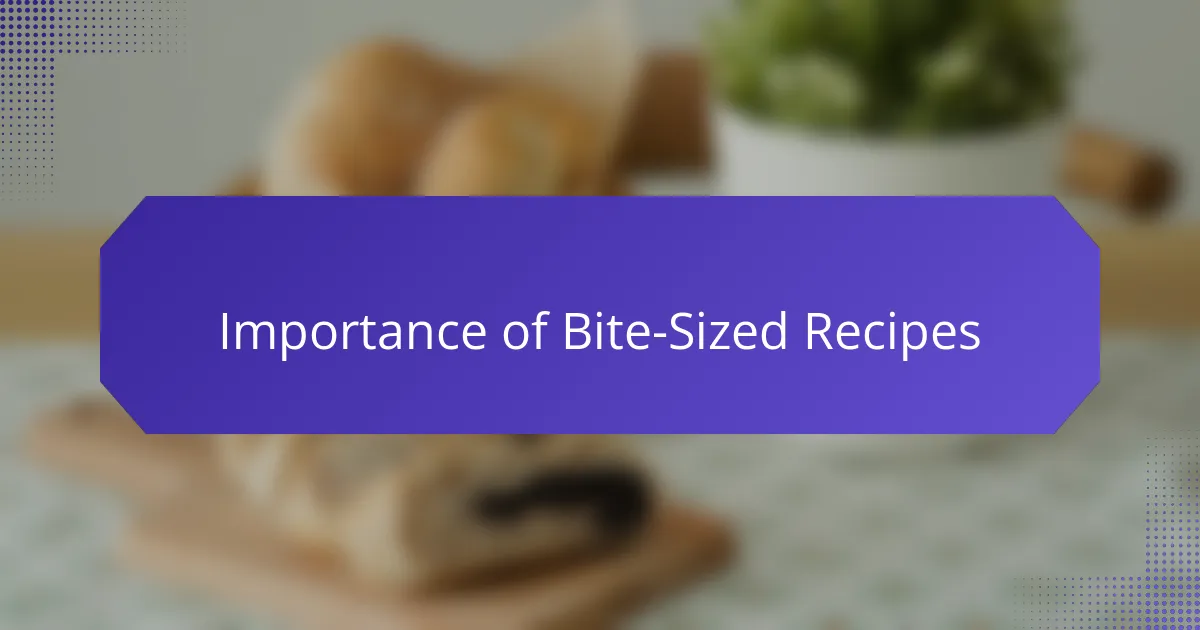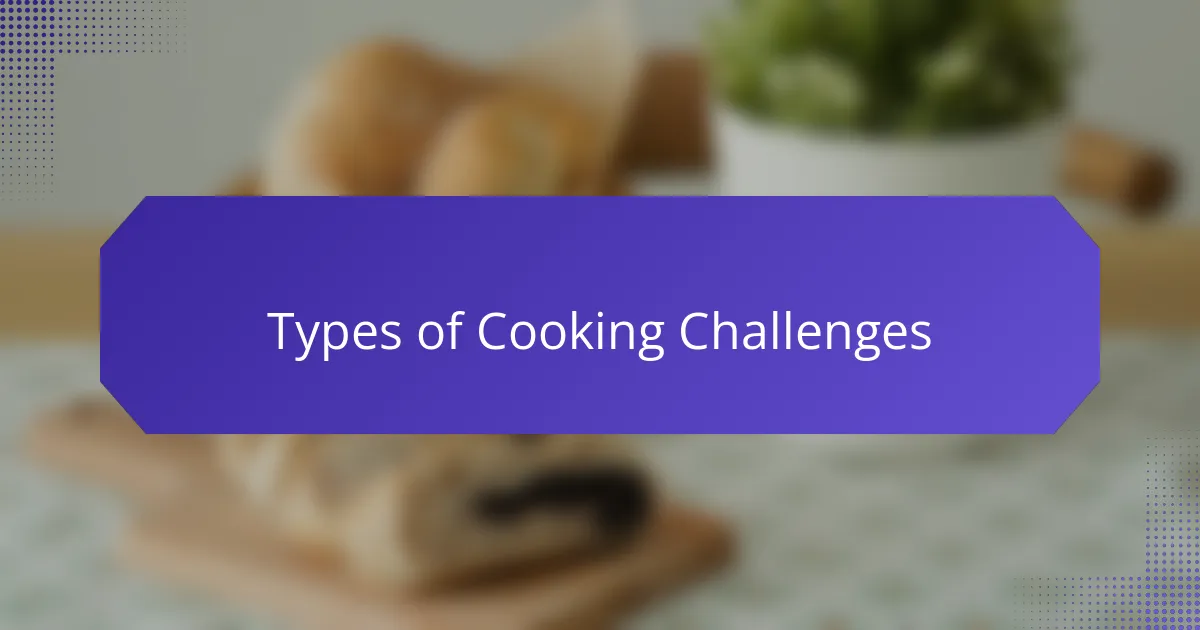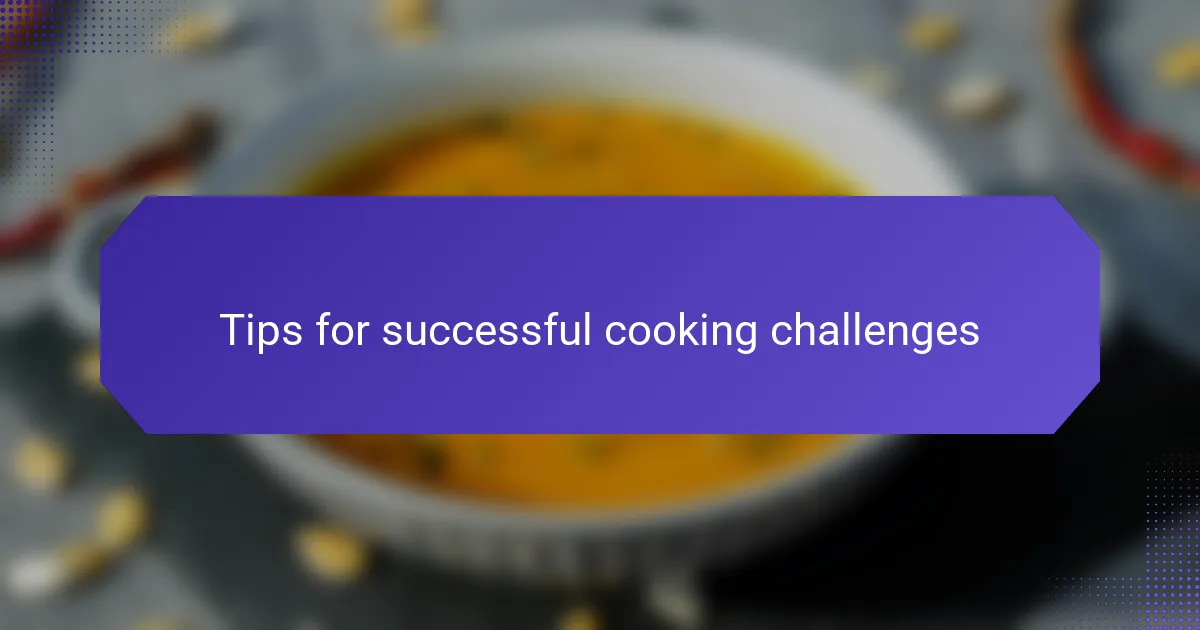Key takeaways
- Cooking challenges enhance creativity and culinary skills through themed ingredients and time constraints.
- Bite-sized recipes promote sharing, variety, and easy meal preparation, fostering a warm dining atmosphere.
- Preparation and organization are crucial for successful cooking; techniques like mise en place streamline the process.
- Embrace flexibility during cooking challenges, as adapting recipes can lead to delicious surprises.

Cooking Challenge Recipes Overview
Cooking challenge recipes offer a unique opportunity to explore new culinary skills while having fun. I remember the first time I participated in a cooking challenge; it felt exhilarating to step out of my comfort zone. Challenges can vary from themed ingredients to time constraints, pushing us to think creatively in the kitchen.
These recipes often combine simplicity with a hint of adventure. Have you ever tried whipping up a three-ingredient dish under pressure? I find that those moments can be both stressful and immensely rewarding, as they teach practical skills and foster a spirit of resourcefulness.
In many ways, cooking challenges bring out our competitive side, while also encouraging collaboration. I recall hosting a friendly cook-off with friends, and the laughter that filled the kitchen made the process memorable. These experiences remind us that cooking is more than just about the food; it’s about connection, creativity, and joy.

Importance of Bite-Sized Recipes
Bite-sized recipes hold a special place in the culinary world. They are not just about smaller portions; they encapsulate the joy of sharing and tasting a variety of flavors in one meal. I remember hosting a gathering where we served a range of bite-sized treats. The smiles and laughter as guests sampled each dish created such a warm atmosphere, showcasing how these small creations can foster connection.
When it comes to meal prep, bite-sized recipes make it easy to explore diverse cuisines without overwhelming the palate. They also encourage creativity, as you can combine different ingredients to make unique combinations. I often experiment with leftovers, crafting simple yet delightful morsels that keep my cooking journey exciting.
Here are some reasons why bite-sized recipes are important:
- Encourages Sharing: Perfect for gatherings, they promote a communal dining experience.
- Variety: Allow for tasting multiple flavors in one sitting without monopolizing the meal.
- Portion Control: Help manage portion sizes, making it easier to enjoy treats without overindulgence.
- Easier Preparation: Less time consuming, they are ideal for busy cooks or quick meals.
- Presentation: Visually appealing, they elevate any meal experience with their creativity.

Types of Cooking Challenges
When it comes to cooking challenges, the variety is truly inspiring. I’ve encountered everything from time trials to ingredient limitations, each pushing my culinary skills and creativity. For instance, the first time I attempted a 30-minute challenge, I was both excited and anxious, but it taught me how to think on my feet and improvise when things didn’t go according to plan.
Additionally, there are themed challenges that can add a fun twist to your kitchen adventures. I remember a color-themed challenge where I had to use only green ingredients. It was a delightful way to explore seasonal produce while creating something visually stunning. These types of challenges not only enhance your cooking abilities, but they also make the process entertaining and memorable.
The comparison table below summarizes different types of cooking challenges I’ve experienced, highlighting their unique features:
| Type of Challenge | Key Features |
|---|---|
| Time Trials | Cook a dish in a set time (e.g., 30 min) |
| Ingredient Limitations | Use only specified ingredients to create a dish |
| Themed Challenges | Focus on a particular theme or ingredient |

Planning for Recipe Selection
When planning for recipe selection, I find it essential to think about the ingredients I already have on hand. This not only saves time but also reduces food waste, which is something that resonates deeply with me. I usually sit down with a cup of tea and jot down ideas for recipes that can incorporate those ingredients, allowing for creativity to spark.
Moreover, I like to consider my audience. For example, if I’m cooking for a group with varying dietary preferences, I make sure to include a mix of vegetarian and gluten-free options. This approach not only makes everyone feel included but also adds an exciting twist to the cooking challenge.
Here’s a comparison table that illustrates two different approaches I use for recipe selection:
| Approach | Description |
|---|---|
| Ingredient-Based | Select recipes based on what you have in your pantry. |
| Audience-Based | Choose recipes considering the dietary preferences of your guests. |

My Approach to Tasty’s Recipes
My approach to Tasty’s recipes has always been about simplification without sacrificing flavor. I remember the first time I tried a Tasty recipe; it was a video tutorial that made everything look so easy. I found myself laughing as I tried to mimic the chef’s techniques—chopping, sautéing, and plating. It was a delightful experience that motivated me to take on more cooking challenges.
I appreciate how Tasty breaks down complicated dishes into bite-sized steps. By focusing on the essential ingredients and techniques, I’ve been able to experiment and add my personal touch. This not only enhances my cooking skills but also brings a sense of joy as I create meals that my family loves.
Here’s a quick comparison of my experience with Tasty’s recipes:
| Aspect | My Experience |
|---|---|
| Difficulty Level | Easy to Moderate |
| Flavor | Consistently Delicious |
| Time Required | Generally Quick |
| Personal Touch | Room for Creativity |

Key Techniques I Used
When tackling Tasty’s bite-sized recipes, I realized that precision and timing are crucial. I remember one particular case where I miscalculated cooking time, and the result was a gummy mess instead of the crisp, delightful bite I was aiming for. This taught me that every second counts, especially with smaller portions, and I learned to break down my steps into a timed checklist.
Another important technique I embraced was mise en place, which means having all my ingredients prepped and organized before starting to cook. It not only made the process smoother but also alleviated a good amount of stress. I found that when my countertop was tidy and everything was at arm’s reach, I could focus on being creative with my cooking rather than worrying about what I was missing.
Key Techniques:
– Measure ingredients precisely for consistent results.
– Use a timer to avoid overcooking or undercooking.
– Prep all ingredients beforehand (mise en place) to streamline the cooking process.
– Experiment with flavors in smaller batches to find the perfect combination.
– Clean as you go to maintain an organized workspace.

Tips for Successful Cooking Challenges
When I tackle cooking challenges, I find that preparation is key. Creating a detailed plan and organizing my ingredients ahead of time reduces stress and makes the cooking process much more enjoyable. I remember a time when I jumped into a challenge without prepping, and the chaos in my kitchen was overwhelming!
It’s also important to stay flexible. Sometimes, a recipe may not turn out exactly as planned, but that’s part of the fun! I once substituted an ingredient last minute, and the result turned out to be unexpectedly delicious. Embracing those little surprises can lead to delightful culinary adventures.
- Make a detailed shopping list to avoid last-minute dashes to the store.
- Prep all your ingredients before starting – it’s called mise en place for a reason!
- Set a timer to keep track of cooking times, but don’t be afraid to adjust as needed.
- Keep a notebook for jotting down insights or modifications for future reference.
- Deploy kitchen gadgets wisely; they can either be your best friends or turn into clutter!


